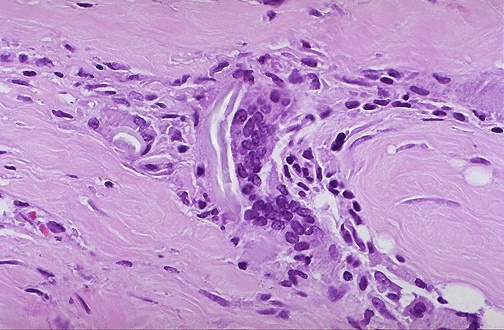
Giant cell reaction

1.
List the cells involved and state their roles
Macrophages � activated macrophage have an epitheloid appearance
and may coalese to form multinucleate giant cells.
Lymphocytes and occasionally plasma cells may form a collar around a
focal collection of epitheloid macrophages.
Fibroblasts � collagen synthesis.
2.
What type of pathological process does it illustrate?
Chronic (granulomatous) inflammation.
3.
Name
some common types of foreign material that can excite this kind of reaction?
Talc, sutures, thorns, silica, glass, grit etc.
(basically anything one would term a physical injurious agent that is
inert & hence would not elicit any chemical reaction as substances like
acids & alkalis would do)
4.
How
do foreign bodies enter the body tissues: skin, lung, liver etc.?
5.
What is the fate of this lesion in the skin?
Chronic granulomatous inflammation.
If foreign material is removed, healing attempts by replacement of
damaged tissues via angiogenesis and fibrosis.
However, according tot Robbins also, granulomas have to be maintained by
cytokines produced by T-cells in the vicinity.
So another guess would be that if the stimulus for T-cell subsides, then
the granuloma would not be maintained any longer� (I�m not sure about this
answer, please help out thanx)
6.
What
other conditions are characterised by granulomatous inflammation with giant cell
formation?
Immune granulomas are another type of granulomatous inflammation and are caused by insoluble particles capable of inducing a cell-mediated immune response. An example would be the bacillus of tuberculosis. In this disease, the granuloma is referred to as a tubercle and is classically characterised by the presence of central caseous necrosis.
<< PREVIOUS INDEX NEXT SLIDE >>
Copyright � Joseph Ong 2003